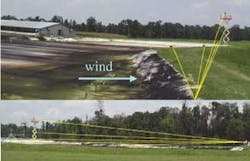Optical technologies are likely to play an essential role in establishing a homeland security infrastructure, but the price tag is not likely to be cheap and the actual threat to the public from sophisticated weapons of mass destruction may have been a bit overblown, according to speakers at the Optical Society of America forum on Homeland Security (Washington, DC; Feb. 19–20).
Many optical technologies under consideration as possibilities for homeland security applications have already established solid track records for similar detection tasks in other applications. For instance, Bruce Harris, a senior project officer at the Environmental Protection Agency (EPA) Office of Research and Development (Research Triangle Park, NC), described the development of open-path Fourier-transform infrared (FTIR) sensing beginning in the 1970s but particularly during the last 10 years for optical remote sensing of fugitive gas emissions. Thomas Giallorenzi, director of the Optical Sciences Division of the Naval Research Laboratory (Washington, D.C.), described the use of fiberoptic sensing arrays in military intruder detection, which has been going on for the past 30 years.
The EPA's FTIR system using off-the-shelf components offers significant potential for scanning for chemical and biowarfare agents, Harris said, because it scans across an entire spectrum, and with appropriate standards for various chemical agents, can identify and quantify target gases as well as provide horizontal and vertical mapping of gas plumes (see figure). Projects for the EPA system have included surveying greenhouse gas distributions, detecting methane leaking from surface mines, gases leaking from pipes and valves in industrial environments, and gases escaping from closed landfills. They have also begun to expand the use of the system into other wavelength ranges.
In terms of protecting buildings and infrastructure from unauthorized intruders, Giallorenzi described a Mach-Zehnder interferometer-based system in which an acoustic or magnetic disturbance alters the signal traveling through an optical fiber, thereby alerting nearby camera systems to check for intruders. "People are trying to develop software packages to go with the cameras to detect motion, to track people, to do face recognition, to do more sophisticated things with existing optical technologies," he said.
Improvements in optical technology are also making cameras and detectors less expensive, but costs will have to drop a great deal further for wide-scale civilian surveillance. "The nice thing about the military at least is that we can concentrate things in bases," Giallorenzi said. "In the civilian infrastructure, you can't concentrate things. You have to reproduce the detection systems many times over."
While the cost of establishing a comprehensive homeland security infrastructure to guard against terrorist attacks using sophisticated weapons of mass destruction may seem prohibitively high, the actual public threat may be lower than most people realize, according to U.S. Army Major Tom Leonard, whose current assignment involves strategic plans and intelligence in the National Guard Bureau's Homeland Security Division. Based in part on research that he performed during a four-year assignment with the counterterrorism division of the Federal Bureau of Investigation, Leonard said that terrorists who are not state-sponsored are more likely to use conventional weapons than sophisticated biological or chemical weapons.
"Non-state-sponsored terrorists are getting a greater interest in acquiring the chem-bio or weapons-of-mass-destruction technology," he said. "But the type of attack that you're going to see most likely will be large-scale vehicular bombs, muggings, shootings, assassinations, and things like that. It's a lot easier to acquire conventional technologies and you get instant feedback."
For instance, in March 1995 in Tokyo, after spending years of research and development and millions of dollars using world-class scientists and facilities, the subway gas attack by the Aum Shinrikyo cult killed only 12 people. "Now if you fast forward to Sept. 11, you've got large-scale vehicular bombs that killed more people than died at Pearl Harbor or on the beaches of Normandy on D-Day," he said. "Chem-bio is exceptionally difficult to weaponize to the degree that's required for mass casualties than more conventional, easily deliverable, easily constructed devices.
"Don't get me wrong," he added. "If somebody actually manages to pull off a weapons-grade chemical or biological attack then that will be horrific, but the current trend right now remains conventional explosive devices or improvised explosive devices. The interest in chem-bio is growing, but they are not quite there yet."
About the Author
Hassaun A. Jones-Bey
Senior Editor and Freelance Writer
Hassaun A. Jones-Bey was a senior editor and then freelance writer for Laser Focus World.
